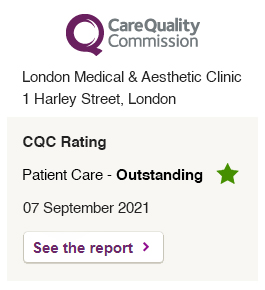Scars are areas of fibrous tissue that replace normal skin after injury, they result from the biological process of wound repair in the skin and other tissues of the body.
Scarring is a natural part of the healing process, with the exception of very minor lesions, every wound e.g. after accident, disease, or surgery results in some degree of scarring.
All scarring is composed of the same collagen as the tissue it has replaced, but the composition of the scar tissue, compared to the normal tissue, is different. Scars differ from other scars in the amount of collagen over expressed.
London Medical and Aesthetic Clinic is one of the leading clinics in Sculptra and CO2 laser treatments in the UK and Europe. Dr Ayham Al-Ayoubi has invited and developed the advanced Sculptra technique combined with CO2 laser to treat deep acne and traumatic scarring which has now been adopted by numerous plastic surgeons and cosmetic doctors worldwide.
Different Types of Scars
Facial scarring is a common complaint among patients. Several etiologies, including inflammatory acne, trauma, previous surgical procedures, and viral infections such as varicella or herpes simplex, can lead to permanent scarring.
There are two broad classifications of facial scarring: Atrophic and Hypertrophic.
We expand upon the classification by dividing atrophic facial scarring into four main types: ice pick, boxcar, shallow/atrophic, and valley/rolling scars.
Ice pick scars are typically small (1-2 mm) and have a wide aperture with steep edges that taper to a single point at the base, as if the skin has been pierced by an ice pick. An epithelial tract forms along the sides of the opening within the scar. These scars may be shallow or deep, and may extend as far as the dermal-subcutaneous junction.
Boxcar scars are round to oval junctions. Boxcar scars are round to oval in shape with well-defined vertical edges and a flat base, as if the scar has been punched out of the skin. They typically range from 0.1 to 0.5 mm in depth and are usually widely spaced out on the skin surface, occurring as solitary scars. Unlike ice pick scars, this type of scar does not converge to a single point.
Shallow/atrophic scars present as a cluster of miniaturized boxcar scars. They usually emerge in groups of four or more and occur mainly on the cheeks.
Valley scars (“rolling” scars) are deeper and have an undulating appearance that is best appreciated in indirect lighting. Valley-shaped scars arise from a variable loss of dermis and/or subcutaneous tissue. Because acne and varicella scars are dermal defects, they require a treatment modality that reaches the dermis in order to achieve clinical improvement.
Before and After photo gallery
Treatment options
Sculptra with Subcision
Sculptra (Poly-L-lactic acid) injection is the most advanced and successful treatment of depressed scars. After anesthetizing the affected areas. The very tiny needle is used and the needle is moved back and forth in a fanning motion to break up the fibrous tissue that is depressing the scar. Sculptra would be injected during subcision procedure which restores lost facial scar volume. Following the procedure, patients can expect slight bruising for up to 1 week.
Dermal Fillers
Soft tissue fillers have been used for decades in the correction of surface deformities. Several factors must be taken into consideration when choosing a filling agent, including: duration of filler, anatomic location, depth of scar to be filled, risk of allergic or granulomatous reaction, and risk of infection.
The most common dermal filer to use to treat scars is Hyaluronic acid which is found throughout the body in connective tissue as well as in synovial tissue and fluid.
Ellansé is made of Poly-caprolactone, is also used to treat scars. it is a well-known totally bio-resorbable soft medical polymer, as well as bio-stimulater of neo-collagenases, it has longer-lasting and sustained results.
Radiesse is a Calcium hydroxylapatite also has been used for superficial depressed scars and acne scars.
Derma Rollers
Sculptra Therapy – Dermaroller significantly improves the appearance of acne scars and stretch marks. Dermaroller Therapy provides advanced micro-medical skin-needling, a procedure that stimulates the skin to regenerate and repair itself naturally and safely, creating smoother, brighter, healthier, younger-looking skin. Cosmetic needling achieves results through increased quantities and access of cell nutrients to the skin, scar tissue, thus optimizing cell function. In addition, injury to the keratinocytes promotes the epidermal growth factor and increases cell turnover.
CO2 Laser Resurfacing
CO2 Laser is a micro ablative laser skin re-surfacing laser can produce improvement in boxcar and shallow atrophic scars. Fractional CO2 micro ablative laser is a safe and effective way to treat acne scars, rough texture on the face, neck, chest, arms and hands and surgical scars, with essentially no downtime. Treated scar areas by the SmatSkin CO2 fractional micro beams, called micro treatment zones, cause sufficient laser injury to promote new collagen production and result in facial skin rejuvenation.
Chemical Peels for Scarring
There are different types of peels which can help with scarring, Medium or Deep Chemical Peel
Medium-depth chemical peels destroy the epidermis and penetrate into the deep part of the skin causing destruction, protein denaturation, and inflammation at a deeper level. This, in turn, results in collagen remodeling and, therefore, scar improvement and tightening. Examples of medium-depth chemical peels include Obagi Blue Peel.
Combination Scar Treatments
Any individual patient may have several different morphological of facial scars and therefore may require a combination of treatments that targets each specific scar type. It is important to understand the timeline of these combination therapies and which treatments may be employed simultaneously versus those that are spaced out several months apart; timing of combination treatments depends on the modalities and mechanisms of action.
Each patient is unique, and clinical improvement may vary significantly among patients. We recommend reassessment of the patient 3 to 6 months following treatment to determine if further procedures would be beneficial.
We present a general guideline of combination treatment options that may be considered in approaching the patient with facial scarring:
Chemical Peels and Laser Resurfacing
Laser Resurfacing and Dermabrasion
Sculptra with Subcision and Laser Resurfacing
CO2 Laser Resurfacing, Sculptra with Subcision and Chemical Peel






























































